The violin is a string instrument with four strings, usually tuned in perfect fifths. It is the smallest member of the violin family, which includes viola, violoncello or ‘cello, and double bass, and has the highest pitch.
The violin, from the Medieval Latin word vitula, which means stringed instrument, was developed in its modern form in 16th Century Italy, and modified throughout the 18th and 19th Centuries. Also known as the fiddle, from the same root, the violin is played in a huge variety of Western music, from Baroque and Classical to Jazz, Folk and even Rock and Pop. It descends from remote ancestors that were used in folk music and played throughout Asia, Europe and the Americas.
The violin was initially a poor-man’s instrument, popular with gypsies and in Jewish culture, easily hand made and robust. There are hundreds of shapes, sizes and designs of these rustic folk instruments throughout the world.
The Chinese fiddle, or Erhu, is a remote ancestor of the violin.
… and the violin is also found in India, where the instrument is the same as a Western violin but the technique of playing differs, with the violin balanced between the left shoulder and the right foot.
The violin is normally tuned to the pitches G, D, A and E, but in Indian music it can be tuned D#, A#, D#, A# and many other pitches are used. In Baroque music and in British and Irish folk music this technique, which is called scordatura, literally meaning mistuning, is frequently used to create entirely different tonalities and harmonic effects.
Making a Violin
The parts of the violin are made from different types of wood. Its sound is dependent on the specific acoustic characteristics of its shape. Sound is produced when a bow is drawn across the strings, or when the string is plucked, causing it to vibrate.
The top of the violin, which is also called the belly or soundboard is made of spruce. The back and ribs are made from maple or sycamore. The best wood for violin making has been seasoned for many years, and the seasoning process continues indefinitely after the violin is made.
The voice of the violin depends on its shape, the quality of its wood, and its varnish. Wood that has grown too quickly in lush environments is considered less resonant, and there is a romantic belief that wood from trees grown in high altitudes and poor conditions produces the best violins.
There has been a huge amount of speculation into the techniques of the Italian master violin-makers of the 17th Century, Stradivarius and Guarnari, whose violins are now investment items selling for many millions of pounds.
This short film explains some possible differences in the wood and varnish preparation, which have created such fine instruments.
The violin is glued with animal hide glue, a soft adhesive that can easily be removed if repairs are needed. The softness of the glue also allows for expansion and contraction of the wood and means that the violin is more likely to come unglued in extreme conditions than for the wood to split. The purfling, the decorative inlay around the body of the violin, is actually designed to protect the edges of the wood from cracking and allows the belly of the violin to flex independently of the ribs.
The arched body with its hourglass shape and curved bouts is essential for the tone. The shape of the instrument is designed to withstand the stress of use and the tensions of the strings, and these curved shapes also give it aesthetic beauty. The design of the violin was influenced by Renaissance philosophies, and results from a fusion of mathematical, aesthetic and scientific principles, not least the Pythagorean teaching that beauty is the result of perfect number ratios.
The neck of the violin is normally made from maple, with an ebony fingerboard. Ebony is used for its hardness and resistance to wear. The neck ends in a peg box and a carved scroll, the fineness of which is often used as an indication of the skill of the violin maker.
This storyboard by Chicago violin shop Fritz Reuter, shows a simple step-by-step illustration of the violin making process.
Why Choose the Violin?
In his book Life Class, Yehudi Menuhin describes the affinity some people have for the violin, explaining that it is not only a melodic instrument, it is also immediately tactile and accessible, even to a child. The violin can be purchased in many different sizes suitable for even the smallest child. These small violins, which can be as tiny as 1/62nd of a full size instrument, are not finely made as they are designed to be resilient for beginners to use, but can be picked up, as Menuhin describes, as easily as a child picks up a teddy bear.
“A child who has a direct natural inclination for the violin has something of an advantage in choosing this instrument over others,” he says. “It is rather like the voice, is a much more tactile instrument than many others and can come in a variety of sizes.
This picture from thesoundpost.co.uk shows the common sizes of beginner instruments for children of different ages.
Menuhin ascribes the appeal of the violin mainly to its sound, which is like that of the human voice.
“With the violin you have to make your own sound and pitch. It is your own voice you are projecting or …learning to project.” He explains that this is why it is possible to distinguish the sounds, tone and styles of different violinists. Playing the violin involves the whole body and this gives the violin the greatest and most immediate range of expression of any instrument.
This playfulness and expression can be seen in this video of a young Sarah Chang playing Sarasate’s Carmen Fantasy.
“I look to the child who, with the child’s confidence, is willing to take up the fiddle, to play it and to play with it, to explore its infinite range of tones and qualities until he finds that voice which is uniquely his own.” Yehudi Menuhin
The scale systems by Carl Flesch and Ivan Galamian are by no means the only in existence, but they have been the most widely used by violin students and teachers for many years. The systems are different in profound ways and each has valid applications for the modern violinist.
Both Galamian and Flesch were master teachers, each from a long line of violin pedagogues. Carl Flesch (1873-1944) was born in Hungary. He began playing at the age of five, and was accepted into the Vienna Conservatoire aged just 13. His students include Henryk Szering, Ida Haendel, Ginette Neveu and Max Rostal.
Flesch believed that violin teaching before Sevçik had been flawed; that Sevçik had proven that advanced technique could be a result of training and not genius. He maintained that all violinists should be schooled sequentially and defined each technical step clearly on the principle that tone quality, intonation, technical proficiency, listening and hearing skills are all things that can be taught.
Ivan Galamian (1903-1981) studied in Moscow. His concert career was short. It was speculated that this was due to chronic kidney stones which left him in great pain after every performance. Galamian used to chain-smoke his way through lessons, perhaps to diminish the pain and keep it from interfering with his teaching. He had moved to New York as the Russian Revolution gathered pace, and once there he founded the Meadowmount Summer Violin School. He also held prestigious teaching posts at the Curtis Institute and the Julliard School of Music. This clip gives some insight into Galamian’s relationship with his students.
Galamian was a consummate teacher, and once remarked, “One must make a choice – either a solo career or a teaching career. You cannot do both equally well. One or the other will suffer.” He explained his enthusiasm for teaching, “Ever since I was a child I have been interested in the how-to-do-it aspect.”
Galamian saw problems in the way violin students were taught. He disagreed with the idea that the violin must be taught from a physical angle, stating that technical mastery depends on the control of mind over muscle, rather than agility of fingers. He also felt the interdependence and relationship of the many technical elements was neglected.
Here is a video of a lesson given by Galamian, cigarette in hand, to a young Joshua Bell. Between the fourth and fifth minute, you can here a G major three-octave scale, from the Galamian scale system.
In order to see the difference in the two systems, let’s have a look at the way they are laid out.
Flesch’s Skalensystem deals with one key at a time. The entire study for that key is contained in one place in the book in sections numbered 1 through 12.
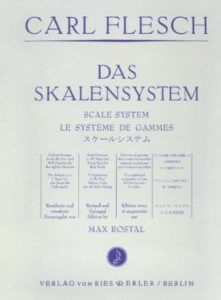
In the new edition there is some attempt to cover four-octave scales but it is not very comprehensive and serves to further overwhelm the student with material. As you progress through the book, different rhythms, bow strokes and bowings are suggested for the study of each key.
Each scale from B flat major up uses the same fingering, always beginning on the second finger. This way, the spacing is learned for every position and intervals remain the same for almost every major and every minor key.
Flesch instructs that scales should be practised slowly for intonation and rapidly for facility, and that the key must be changed every day. In the modern edition, Max Rostal suggests in his preface that the key may be changed twice a week. He also explains that focus should be on the legato bowing with bowing exercises added later, as the initial goal is to develop left hand technique. Legato playing allows for the development of inaudible shifting and controlled string crossing. Rostal also suggests less time consuming programmes for studying the system, selecting parts of the designated key each day.
This is all perhaps rather overwhelming. Particularly since the advent of television and Internet we all have much less time to practice. This system would be ideal if within 45 minutes each day we were able to cover a complete key as Flesch suggests, but it is not actually possible to do! What can happen is a lot of arduous, unrewarding work and the onset of a deep hatred of scales because Flesch just seems too difficult.
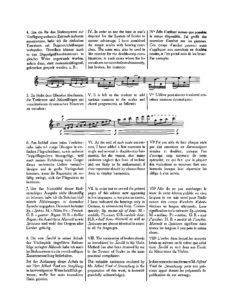
The Galamian system, Contemporary Violin Technique is more visually approachable, and is also less prescriptive. It comes in two volumes (Vol. 1, Vol. 2).
Volume One covers single stopped scales. The sections are:
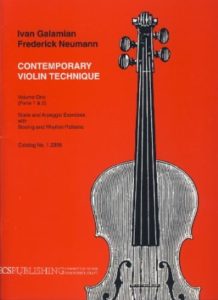 This book is written with only the note heads and no note values. There are several suggested basic bowing patterns to work from. There is then a second book, which contains rhythmic variations for the bowing patterns. Galamian also uses more diverse fingerings rather than applying one fingering to every key.
This book is written with only the note heads and no note values. There are several suggested basic bowing patterns to work from. There is then a second book, which contains rhythmic variations for the bowing patterns. Galamian also uses more diverse fingerings rather than applying one fingering to every key.
The main feature of the Galamian scales which differs from the Flesch, is the Galamian turn. At the start of the three octave scales, the third note is played immediately after the first, then back to the second and first notes before ascending, so a G major scale would start like this: G B A G A B C D and so on. This turn is repeated at the end of the scale. The result of this is that every three-octave scale has exactly 48 notes, 24 on the way up and 24 on the way down. This means that the notes are divisible by 3, 6, 8, 12 or 24 notes per bow. This facilitates Galamian’s Acceleration Series. He suggests the student puts on a metronome at crotchet (quarter note) = 60 or 50, or even slower, and begins the scale slurring two quavers (eighth notes) per beat. The scale then progresses to three notes per beat, then four, six and so on. The left hand speeds up and the right hand maintains the same bow speed, but with faster, more fluid string changes. This fulfils Rostal’s suggestion that the legato playing to facilitate development of left hand technique is most important.
Once this is done, bowing patterns can be imposed on the scale. In this way, a strong foundation is laid in the left hand for good intonation in every position, and the student also has a daily outlet for working on bowing techniques.
The less prescriptive fingerings of the Galamian book are useful in repertoire. There is no correct fingering for scales or pieces. In the Flesch system, scale patterns are memorised easily because the fingering remains the same, but fingerings serve a purpose. The more fingerings a student can learn, the more artistic choices are available.
The Galamian book is also more approachable for intermediate level players. The Flesch book looks frankly impossible to the less ambitious or advanced player, but with Galamian it’s possible to start at whatever level you have reached.
The second volume of Galamian’s scale system comprehensively covers double and multiple stops. My violin professor, Howard Davis, who had studied with Frederick Grinke, himself a pupil of Carl Flesch, used to prescribe ten minutes a day of thirds, ten of sixths and ten of octaves, played with a metronome at crotchet = 60, four beats to a note. “That’s all you need to do,” he’d say.
The purpose of practising scales is to build technique. The purpose of building technique is to facilitate more beautiful interpretation of repertoire, and scales provide the most effective targeting for this. Using scales, the violinist can work on intonation, rhythm evenness of tone, constant bow speed, beauty of tone, relaxation, breath, shifting, posture and many other aspects of playing.
Some students may prefer the stricter layout of the Flesch book, where everything for each key is in one place. Others may prefer the open ended system by Galamian, in which it’s possible to pick and choose what to cover and how. I would suggest that the Galamian system might show improvements more quickly as it is easier to be more random with the approach to practice, giving the brain new problems to solve rather than repeating a section until it is right.
These two books on the study of scales are by no means the only ones available. The newest on the market is by Simon Fischer, who has written two other books of technique, Basics and Practice. His book Scales, is designed to counteract the problems many people suffer when approaching scale practice. Fischer maintains that since the main purpose of scale practice is to build technique, it is important to work on the elements of the scale even more than on the complete scale. Instead of the traditional scale system, he gives a detailed analysis of how intonation works and provides exercises to develop shifting, string crossing and intonation within the scale. He then develops the practice in a streamlined way, connecting the whole scale together.
With any scale system, the trick is to maintain focus, discipline and creativity in practice. Perhaps the best solution is to use several different systems and take what you can from each. Sometimes we want to be challenged, at other times we want to explore.
In the context of violin study, where so much knowledge is passed on verbally in lessons, it is a huge privilege to have these works available to give us a window into the teaching of some of the greatest violin teachers, who’s approach would otherwise have been diluted or lost altogether.
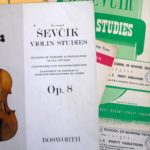 Pattern building studies for the violin are composed around simple ‘building-block’ phrases and repetitive figures, designed solely to build finger strength, agility and facility. There are many such studies in the violin repertoire, the best of which are the study books by Sevçik and Schradieck which, when practiced correctly, build left hand technique and strength comprehensively and incrementally. These books are essential supplementary material for scale and study practice and contain repetitive drills, covering all possible approaches to any particular problem.
Pattern building studies for the violin are composed around simple ‘building-block’ phrases and repetitive figures, designed solely to build finger strength, agility and facility. There are many such studies in the violin repertoire, the best of which are the study books by Sevçik and Schradieck which, when practiced correctly, build left hand technique and strength comprehensively and incrementally. These books are essential supplementary material for scale and study practice and contain repetitive drills, covering all possible approaches to any particular problem.
Study of the pattern building exercises in these books hones basic skills, resolves the technical issues which hamper musical performance and leads to large jumps in technical improvement. Where a repertoire-rich practice diet can miss out the basics, covering these supplementary studies, which are sometimes shunned because they seem dull and dry, gives solid technique and avoids the need for rehabilitation in the future.
In his 1986 introduction to the Flesch Skalensystem, violinist Max Rostal explains that the best way to build intonation and facility is by practicing technical difficulties in isolation. For example, he says a problem with intonation or shifting must be approached by deciphering and improving how the wrong note is accessed. Since Sevçik’s Opus 8, Studies in Changes of Position and Preparatory Scale Studies, is the most comprehensive book on shifting that exists, there is therefore no reason why a student wishing to improve shifting, intonation and facility would avoid it.
Pattern building exercises may be considered old fashioned by some teachers, but they are designed with a deep understanding of how the muscles and brain learn, an understanding which can be explained with recent discoveries in neurological science.
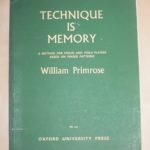
In 1959, William Primrose, the famous viola player who performed and recorded chamber music with Jascha Heifetz, published his book, Technique is Memory. In his introduction he states, “This book is not for geniuses.”
Primrose’s book is based entirely on the study of left hand finger patterns. He explains that, “To know when to put a finger in a given place at a given time; to know also its position relating to the other three fingers at that particular place and time, is to know all that is necessary in the search for accuracy.
“Technique is a means to an end,” he says. “There is no short-cut to efficiency on any instrument that will bypass systematic practice.”
His book is thoroughly systematic. It covers every key in every position, aiming to cover the entire topography of the fingerboard. Primrose explains that if technique is memory, it follows that the eye plays an important role in pattern building practice. The route is eye to brain, brain to finger, finger (or the sound produced by it) to ear and ear to brain. In his book, numbered groups of fingers are connected with symbols, designed to be filled in by the student in colour; red for semitones, green for whole-tone sequences and so on. Each scale is practiced very slowly at first and then repeated faster. Primrose concludes that when study of the book is complete, the student should be able to recall verbally, whilst away from the instrument, the finger pattern of any scale in any part of the instrument.

The violin has a range of about four and a half octaves, or 54 semitones. There are at least 100 different places in which to play the 54 semitones, since many are playable in more than one place. It makes sense then that detailed study of the left hand patterns is required to build good intonation and knowledge of the fingerboard. We talk about muscle memory, but that is quite a lot for the muscles to remember!
Ivan Galamian explains in his book, The Principles of Violin Playing and Teaching (1962), that the foundation upon which the technique lies rests upon the correct relationship of the mind to the muscles, the smooth, quick and accurate functioning of the sequence in which the mental command elicits the desired muscular response. The greater this correlation, the greater the facility. Interestingly, neurological science has only recently been able to prove this idea, which the great violin teachers already understood and implemented in their pattern building approach.
|
Further recommended reading:
|
As recently as the 1980’s neuroscientists discovered the importance of a neural insulator called myelin. Every human skill is created by chains of nerve fibres carrying electrical impulses. As these impulses are repeated, myelin, or white matter, wraps the fibres in the same way that we insulate an electrical wire. This insulation makes the signal stronger and faster by preventing the electrical impulses from leaking out.
When we practice a pattern building exercise, a neural circuit is fired and the myelin responds by wrapping layers of insulation around it. Each new layer adds a bit more skill and speed. Skill can therefore be describes as a cellular insulation which wraps neural circuits. Experiences where you are forced to slow down, make errors and correct them, repeat the same constructive piece of study many times; which is exactly how you would be approaching an exercise from a book of Sevçik; result in greater fluency.
In an interview with Daniel Coyle, author of The Talent Code, Robert Bjork, chair of UCLA explains, “We tend to think of our memory as a tape recorder but that’s wrong. It’s a living structure, a scaffold of nearly infinite size. The more we generate impulses, encountering and overcoming difficulties, the more scaffolding we build, the faster we learn.”
The more you fire a particular circuit, the more myelin optimises that circuit, and the stronger, faster and more fluid your playing will become, just as Galamian said. Targeted practice of pattern building exercises is effective precisely because the best way to build good circuits is to fire them over and over again. This is the science behind the 10,000 hour rule; the theory that to acquire mastery in any given skill, 10,000 hours of targeted, concentrated practice is required.
In his book, Practice, violinist and teacher Simon Fischer also describes how improving technique means building an ever larger collection of automatic, unthinking actions that have a desired, not an undesired effect.
Pattern building exercises are a chance to linger in the early stages of technical acquisition, maintaining a child-like curiosity for the instrument. Small children love this sort of skill mastery. A child will never seek reasons, justifications or explanations the way older students and adults do. Children are physical learners, and instinctively understand that technique facilitates more genuine responses to music. When we play musically and with inspiration, a better feeling comes into the muscles than when we play mechanically. Passion and persistence are key.In his book, Practice, violinist and teacher Simon Fischer also describes how improving technique means building an ever larger collection of automatic, unthinking actions that have a desired, not an undesired effect.This is the science behind the 10,000 hour rule; the theory that to acquire mastery in any given skill, 10,000 hours of targeted, concentrated practice is required.
To avoid over-practicing, or falling into the trap of playing these exercises mechanically, always practice with a goal in mind. What would you like to play better? Use the exercises according to your needs. Practice them regularly but only for a short, concentrated period, optimising your circuit building. The objective is not to learn a particular book of Sevçik or Schradieck in its entirety, or to get through all of the exercises as fast as possible; the reward is in the increased complexity of personal ability which comes as a result of mixing and matching the exercises with scales, studies and repertoire.
The Schradieck exercises are extremely helpful in that their focus on left hand co-ordination can be added to with variations in bowing style and technique. This exponentially increases the benefit of the work, and makes it more fun and more rewarding. In a postscript to Galamian’s Principles of Violin Playing and Teaching, former student, Elizabeth A H Green recalls how Galamian used studies as a “panorama of pertinent technique.” Various rhythms and diverse bowings were superimposed on left hand work, always creating problems for the mind to solve. The variations would become gradually more demanding, and she describes transcending technical problems as the exercises resulted in rapidly accelerated learning.
[gview file="https://www.violinschool.com/wp-content/uploads/2015/04/Henry-Schradieck-School-of-Violin-Technique-Book-1.pdf"]
Finally, these books of pattern building studies are designed to fulfil a purpose: to provide a means of study for thoroughly learning the basis of a strong, reliable technique and an understanding of the geography of the instrument. Be careful to avoid becoming obsessive or overly perfectionist, as this will render them dull and counterproductive. This kind of analytical work can be stultifying for right-brained and creative thinkers and should only be approached in a creative, explorative and musical way. Perfectionism seems a natural outcome of something so thorough as a volume of shifting exercises, but perfectionist expectations lead to a detachment from the body and a self-apologetic approach. Repetitive work becomes less effective when we are bored, so try a random approach to repetition, working alternately on several different exercises and mixing up bowing patterns and rhythms.
| To understand more about the value of repetitive practice within a randomized schedule and with variations of rhythm and bowing, read this post by clarinetist Christine Carter. |
Make sure you know the reason for practicing each exercise; remind yourself of your intention for practicing; observe your work carefully to ensure you are getting good results in small, concentrated time slots; play musically and enjoy the process of discovery.
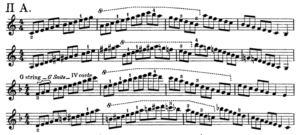 Scales are basic patterns of notes, ordered by pitch, most often in ascending then descending order. Each major or minor scale covers all of the notes of the key in which it is played; a chromatic scale contains every semitone within an octave span. There are double-stopped scales in thirds, sixths and octaves, arpeggios, pentatonic scales, scales in harmonics, scales of three, even four octaves, lengthy violin scale systems, intimidating Germanic directories of scales displaying every key, every position and every conceivable bowing. Every piece of music composed between the Baroque and Romantic periods; that’s three hundred years’ worth of repertoire; is made up of scale and arpeggio patterns.
Scales are basic patterns of notes, ordered by pitch, most often in ascending then descending order. Each major or minor scale covers all of the notes of the key in which it is played; a chromatic scale contains every semitone within an octave span. There are double-stopped scales in thirds, sixths and octaves, arpeggios, pentatonic scales, scales in harmonics, scales of three, even four octaves, lengthy violin scale systems, intimidating Germanic directories of scales displaying every key, every position and every conceivable bowing. Every piece of music composed between the Baroque and Romantic periods; that’s three hundred years’ worth of repertoire; is made up of scale and arpeggio patterns.
But scales are not music. Unless you are taking an exam you will never be expected to perform them. Who wants to go to a scale recital, after all? It is easy to understand why many of us consider scale practice a chore to be avoided, yet we are encouraged every lesson to spend time practising our scales.
The famous violin virtuoso and teacher Yehudi Menuhin, who made his first public appearance aged just 7, explains in his autobiography, Unfinished Journey, that as a child he considered learning an imposed method of scales, arpeggios and theory a waste of time. He learned instead by doing, acquiring the techniques for each piece as he studied it; wishing only to make music. Menuhin describes the journey he then undertook when, as he got older, determined to maintain his high performance level and also become a great teacher, he began to realise that he had skipped the basics. He had no idea how he did what he did.
To fully understand the way his fingers moved, Menuhin decided to go back, even at the risk of losing the skill he had acquired, and learned every scale there is at every speed. He learned the anatomy of the muscles in his back; he studied yoga; he sought advice from violin teachers, dancers and even gymnasts to understand how his body worked when he played the violin. Menuhin writes, “There is an advantage in establishing the top story of one's constructions first: One has seen the heights; one knows what one is building for and what must be sustained,” but “'Undoubtedly I had lost time in balking at scales and arpeggios.”
The truth is, scale practice is crucial to your violin technique, and, as Menuhin’s detailed explorations show, it doesn’t have to be boring.
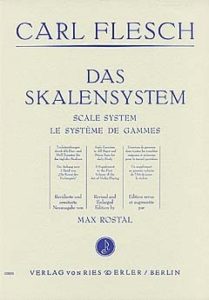
Scale practice is repetitive by nature. Scale systems like those by Carl Flesch and Ivan Galamian offer a comprehensive study guide, often with three octave scales using the same fingering in each key. Instructions for study are included, but these can seem unrealistic to a modern student with little time to practice. The best way to practice is therefore to tackle scales with full concentration and musical intent, essentially condensing the fundamentals of music into a daily routine.
The reason scale practice works is because the brain needs repetition to learn. Neurologists have discovered that when a new neural pathway is created, which happens every time you do something new, for example when you play D major scale for the first time, insulating fibres grow around that neural pathway. When the pathway is used repeatedly, the insulating layer increases, embedding the action in your long-term memory. It takes between 30 and 50 perfect repetitions of an action to imbed it in your nervous system where it becomes a habit or skill. When we are emotionally engaged in learning, this process is much more effective. Learning the placing of first and second fingers on the A string with a mediocre tone and little enthusiasm will therefore not produce the same results as engaging fully in the idea of a ringing tone and musical outcome.
Played with full concentration and a musical approach, scales build a consistent practice routine in which you become familiar with the proper spacing of intervals on the instrument. Slow scales can be used as a physical warm up, but above and beyond this initial function, scale practice is invaluable in maintaining and developing every aspect of your violin technique.
Scale practice gives you a chance to acquire a really firm left hand technique. It builds strength, independence and dexterity in the left hand fingers. Co-ordination of left hand and bow hand improve. Touch control and sensitivity of the left hand fingers can be developed within a familiar practice pattern to avoid over-pressing, as can secure knowledge of the fingerboard and perfect intonation, a rhythmic left hand, tidy shifting and shifting with the whole hand. Mastering scales allows the fingers to learn the correct spacing in every position on the violin.
Scale practice can also be used to work on ease of playing, with focus on a relaxed bow arm, different bowing styles, full bows and purity of tone.
Ease of playing decreases risk of injury and stress, and a genuine understanding of how your technique works leads to consistent, secure performances. Familiarity with scales in every key gives a new ease to note reading and improves sight-reading, as well as improving knowledge of key signatures and tonality.
Start slowly, with the metronome, focussing on your sound, purity of pitch and beauty of tone. Enjoy the experience of listening to your own violin. Work out a clear goal or intention for this section of your practice, and engage with the process of full concentration for a short period of time. Use your scale practice mindfully and creatively. Challenge yourself to expand your technique and your understanding of how scales work for you.
So... why play scales? Because they are interesting, musical, challenging and really, really useful!
